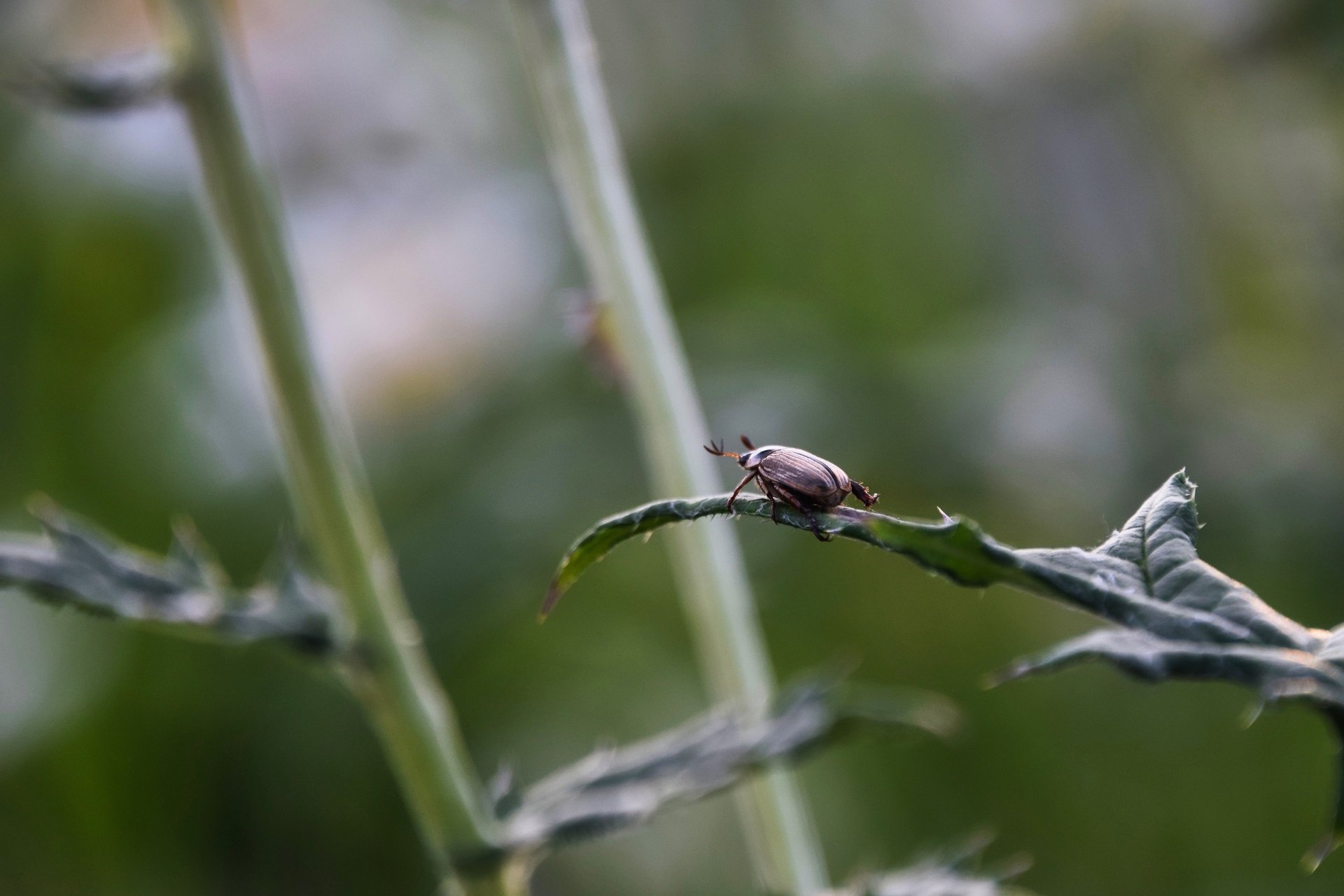Japanese Beetles
The Japanese beetle (Popillia japonica) is an introduced insect first discovered in the United States in New Jersey in 1916. It was accidentally brought into this country on iris roots from Japan. It can be found in nearly every state east of the Mississippi. It has spread rapidly due to lack of natural enemies.
The grubs (the larval or immature stage of the beetle) are possibly the most common lawn pest in New England. In fact, Japanese beetle grubs make up about 90 percent of the white grubs that live in Massachusetts lawns.
Identification
The adult beetle is 1/4 to 1/2 inch in length and metallic blue or green with coppery colored underside and wing covers. Patches of white hair can be found on the abdomen and below the wings. Adults emerge from the ground in late June and early July from the pupa state.
Warm, sunny days draw beetles out in larger numbers. They live only four to six weeks and are most active from about 9 am to 3 pm. The females lay eggs 30 to 45 days later and continue to be active in July and August.
Their eggs are yellowish-white, elliptical or spherical in shape, and are laid about 3 inches into the soil in grassy areas, often in closely cut grass. The females lay 1 to 4 eggs at a time and about 60 eggs during the season. They hatch into grubs in about two weeks.
The grubs can be recognized by the distinctive C-shape they take when curled up. They are white or cream in color, have three pairs of legs, and a hard brown head. The grub stage is about 10 months long. They then go into a brief pupa or resting stage in late spring where they change into a beetle.
Situations & Solutions
The non-native Japanese beetle can wreak havoc on yards, plants, and shrubs. They are the most destructive insect to lawns.
Damage to Plants
The adult Japanese Beetle feeds on over 300 kinds of trees, shrubs, grass, field crops, and garden plants and are more likely to feed in open areas on warm, sunny days. It eats leaves, flowers and occasionally fruits often on plants in the rose and grape families. They can strip a plant of its leaves, sometimes called "skeletonizing", with only the veins of the leaves being left.
This can lead to the death of a plant or they can weaken it considerably. The beetle does have natural enemies such as various parasitic wasps and flies.
Damage to Lawns
Grubs eat the roots and underground stems of plants, especially grass, in April and May and again in August through October and then hibernate during the winter.
The grass may appear brown and blotchy where grubs are eating, and since they eat the grass roots, the grass can be rolled up like a carpet. If a lawn is being dug up by skunks, raccoons, or crows, particularly in March through May or in September or October, or if moles are creating a network of tunnels under the grass, it is likely that the lawn has a significant population of grubs which the animals are feeding on.
To protect your lawn from damage caused by skunks, crows, and moles, loosely place fruit-tree netting placed over a lawn. Do not pull it taut, instead, loosely gather the netting, especially 3 or 4 feet along each outside edge. Birds and mammals do not want to walk on the netting thus preventing further damage to the lawn.
Place 15 inch high stakes around an area you want to protect or that has already been dug up by animals. Attach 2 or 3 inch wide silver Mylar tape (purchased at party supply stores) to the stakes and crisscross the area with the tape. The area can remain covered until the beetles emerge in June or, if it is fall, until the weather cools around October. By then, the grubs will start to hibernate deeper in the soil.
When to Take Action
The quantity of grubs can be anywhere from 175 to 1,531 per square yard of grass. To determine whether or not there is a significant number of grubs to warrant control practices, remove a square section of lawn 6 inches by 6 inches and 4 inches deep.
Turn the section of lawn unto a flat surface, use a trowel to break up the soil, and place any grubs you find in a cup. A healthy lawn can usually tolerate 8 to 10 grubs per square foot without showing signs of distress.
Management Options
There are several options to control an excess of grubs and the adult beetle.
- Milky spore disease (Bacillus popilliae) is a bacterial infection fatal to Japanese beetles, yet does not infect other insects, earthworms, birds, mammals, humans, or plants. In order for this option to be effective, it needs to cover large areas, the soil temperature must be 70 degrees or above when applied, and soil must be 72 degrees or above for 3 months.
- Handpicking the beetles on shrubs and other plants. In early morning they can be shaken from plants onto a cloth where they can be collected and destroyed by immersion in soapy water.
- Using small portable vacuum with a detachable bag in the morning, putting the paper bag in a plastic bag, and placing the bag in the sun will kill them.
- Japanese beetle traps are effective when placed at the outside corners of a property at intervals of 150 to 200 feet around the area you are trying to protect. It’s important to have more than one trap, as just one can actually attract more beetles. The traps attract beetles by containing chemicals, which mimic flower scents and the female beetle scent. Traps should be emptied regularly; to destroy the beetles, place them in soapy water.
A Note on Chemical Controls
There are many products on the market such as diazinon and chlorpyrifos (Dursban), but most of them are harmful to birds, other insects, and people. Therefore, we do not recommend them.



